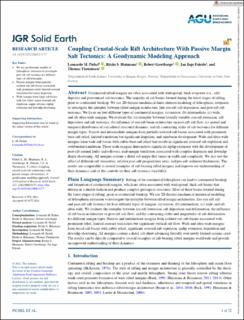| dc.contributor.author | Pichel, Leonardo Muniz | |
| dc.contributor.author | Huismans, Ritske Sipke | |
| dc.contributor.author | Gawthorpe, Rob | |
| dc.contributor.author | Faleide, Jan Inge | |
| dc.contributor.author | Theunissen, Thomas Louis Roger Dominique | |
| dc.date.accessioned | 2023-02-14T13:30:33Z | |
| dc.date.available | 2023-02-14T13:30:33Z | |
| dc.date.created | 2022-11-19T14:17:52Z | |
| dc.date.issued | 2022 | |
| dc.identifier.issn | 2169-9313 | |
| dc.identifier.uri | https://hdl.handle.net/11250/3050761 | |
| dc.description.abstract | Continental rifted margins are often associated with widespread, thick evaporite (i.e., salt) deposits and pronounced salt tectonics. The majority of salt basins formed during the latest stages of rifting, prior to continental breakup. We use 2D thermo-mechanical finite element modeling of lithospheric extension to investigate the interplay between rifted margin architecture, late syn-rift salt deposition, and post-rift salt tectonics. We focus on four different types of continental margins: (a) narrow, (b) intermediate, (c) wide, and (d) ultra-wide margins. We evaluate the: (a) interplay between laterally variable syn-rift extension, salt deposition and salt tectonics, (b) influence of syn-rift basin architecture on post-rift salt flow, (c) spatial and temporal distribution of salt-related structural domains, and (d) contrasting styles of salt tectonics for different margin types. Narrow and intermediate margins form partially isolated salt basins associated with prominent base-salt relief, limited translation but significant diapirism, and minibasin development. Wide and ultra-wide margins form wide salt basins with subtle base-salt relief that results in significant seaward salt expulsion and overburden translation. These wide margins demonstrate significant updip extension with the development of post-rift normal faults and rollovers, mid-margin translation associated with complex diapirism and downdip diapir shortening. All margins contain a distal salt nappe that varies in width and complexity. We also test the effect of different salt viscosities, relative post-salt progradation rates, and pre-salt sediment thicknesses. The results are comparable to several examples of salt-bearing rifted margins and improve our understanding of their dynamics and on the controls on their salt tectonics variability. | en_US |
| dc.language.iso | eng | en_US |
| dc.publisher | AGU | en_US |
| dc.rights | Attribution-NonCommercial-NoDerivatives 4.0 Internasjonal | * |
| dc.rights.uri | http://creativecommons.org/licenses/by-nc-nd/4.0/deed.no | * |
| dc.title | Coupling Crustal-Scale Rift Architecture With Passive Margin Salt Tectonics: A Geodynamic Modeling Approach | en_US |
| dc.type | Journal article | en_US |
| dc.type | Peer reviewed | en_US |
| dc.description.version | publishedVersion | en_US |
| dc.rights.holder | Copyright 2022 The Author(s) | en_US |
| dc.source.articlenumber | e2022JB025177 | en_US |
| cristin.ispublished | true | |
| cristin.fulltext | original | |
| cristin.qualitycode | 2 | |
| dc.identifier.doi | 10.1029/2022JB025177 | |
| dc.identifier.cristin | 2076733 | |
| dc.source.journal | Journal of Geophysical Research (JGR): Solid Earth | en_US |
| dc.identifier.citation | Journal of Geophysical Research (JGR): Solid Earth. 2022, 127 (11), e2022JB025177. | en_US |
| dc.source.volume | 127 | en_US |
| dc.source.issue | 11 | en_US |

